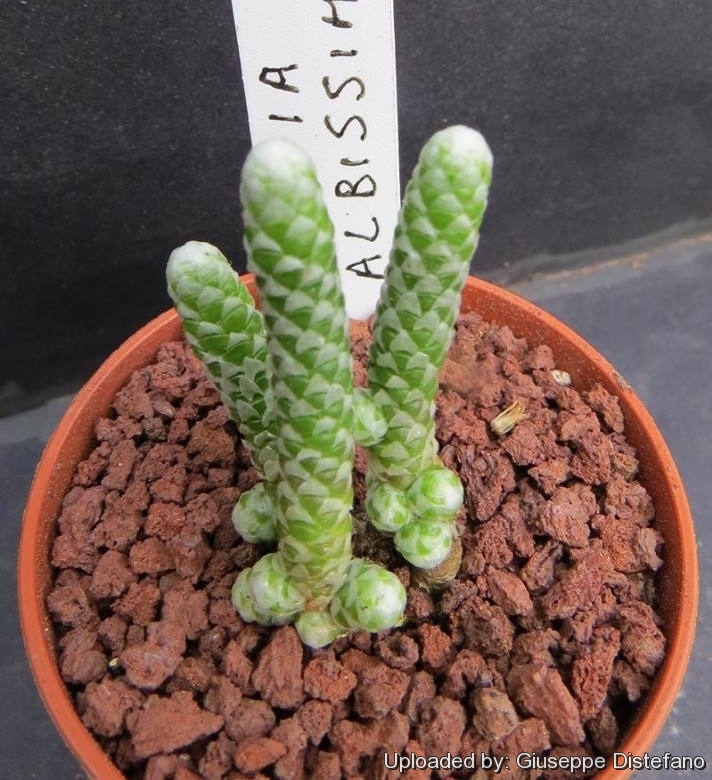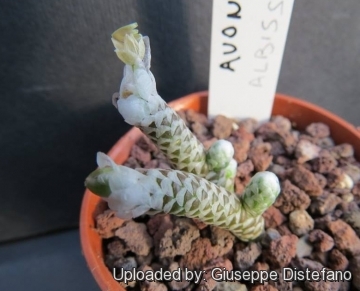
Avonia albissima Photo by: Giuseppe Distefano
Origin and Habitat: Avonia albissimaSN|11042]]SN|27288]] occupies some of the same territory of Avonia papyraceaSN|27288]]SN|11042]] in South Africa ( Richtersveld), but also grows a bit farther to the north in Namibia, and , and eastwards through Bushmanland to Griqualand West.
Habitat and Ecology: Major habitats Desert, Nama Karoo, Succulent Karoo. This species grows, in sandy gravel, rock outcrops and quartz flats either in the open or within the shade or at the base of rocks, and the plants look just like bird droppings from a distance as its shoots is hardly distinguishable from the environment. It also grows on marble outcrops in the Welwitschiaflache north of the Swakop. Its roots penetrated up to 30 centimetres down into the substratum consisting of small stones, varying in size from 1 to 4 cm in diameter and very tightly compacted. This explains why plants often have deformed or misshapen roots where they have struggled to penetrate this very solid ground. This succulent appears to derive its nutriment not from the usual humus, but from the sand itself which is very rich in minerals. It is widespread and not in danger of extinction. The population trend is stable.
Synonyms:
See all synonyms of Avonia albissima
Common Names include:
ENGLISH: 妖精之舞
Description: Avonia albissimaSN|27301]]SN|27288]], formerly known as Anacampseros albissimaSN|27289]]SN|27289]], is a small whitish plants forming a tuft of erect stems branched low down. Its branches are numerous, thin, cylindrical, and reclining , emerging from a short taproot (caudex). The flowers are terminal, white, and appear singly or in groups of 2 to 3. It is similar to Avonia papyraceaSN|11042]]SN|11042]], but with narrower branches and a perhaps sleeker appearance. Treated as one large variable species by Gerbaulet (1992) including many earlier names.
Rootstock (caudex): Short, fleshy, somewat woody, equipped with fleshy roots. Crown small, below ground.
Branches: Numerous, spreading or erect, up to 5 cm long, 3-5 mm in diameter overall.
Leaves: Completely concealed the stipules. Stipules broadly ovate, obtuse, tightly imbricate, pressed tight to the shoot axis, but with the tip sometimes recurved, dished, entire or irregularly toothed, pure white with-out evident midrib but sometimes with a brown tip, sometimes with brown dots, hairy within at the axils.
Flowers: 1 - 3 per branch, scented, 12 mm in diameter. Sepals whitish. Petals ovate, white, opening widely. Stamens 8 -10.
Fruits (capsules): Subglobose, 3 mm in diameter.
Seeds: Subglobose, beaked, colliculate, with white papillae.
Chromosome number: 2n = 18.
Similar species: Avonia recurvataSN|27288]]SN|27301]] subs. buderiana is very similar with the hairs at the base of the stipules very few or absent.
Bibliography: Major references and further lectures
1) Urs Eggli “Illustrated Handbook of Succulent Plants: Dicotyledons” Springer Science & Business Media, 2002
2) Cactus and Succulent Journal, 77:1-6, 15, 2005
3) The National Cactus and Succulent Journal: The Official Journal of the National Cactus & Succulent Society, volumes 35-37 page 37, National Cactus and Succulent Society, 1980
4) Gerbaulet, M. “Die Gattung Anacampseros L. (Portulacaceae).” I. Untersuchungen zur Systematik. Botanische Jahrbücher für Systematik 113(4):477-564.1992.
5) Rowley, G.D. “Anacampseros and allied genera - a reassessment.” Bradleya 12:105-112.1994.
6) Snijman, D.A. “Plants of the Greater Cape Floristic Region 2: The extra Cape flora.” Strelitzia 30. South African National Biodiversity Institute, Pretoria. 2013.
7) von Staden, L. “Anacampseros albissima Marloth.” National Assessment: Red List of South African Plants version 2015.1. Accessed on 2015/12/07 2015.
8) Stuart Max Walters “European Garden Flora: A Manual for the Identification of Plants Cultivated in Europe, Both Out-of-Doors and Under Glass” Cambridge University Press, 27 July 1989
9) Werner Rauh “The Wonderful World of Succulents: Cultivation and Description of Selected Succulent Plants Other Than Cacti” Smithsonian Institution Press, 1984
10) Hermann Jacobsen “A handbook of succulent plants: descriptions, synonyms, and cultural details for succulents other than Cactaceae” Volume 1 Blandford Press, 1960
11) Richard F. Logan “The Central Namib Desert, South West Africa” National Academies, 1960
12) Namib Desert Research Station “Scientific Papers of the Namib Desert Research Station” Edizioni 1-17 Namib Desert Research Station, 1961
13) Doreen Court. “Succulent flora of South Africa”. 1981.
14) Stuart Max Walters “European Garden Flora: A Manual for the Identification of Plants Cultivated in Europe, Both Out-of-Doors and Under Glass” Cambridge University Press, 27 lug 1989
 Avonia albissima Photo by: Giuseppe Distefano
Avonia albissima Photo by: Giuseppe DistefanoSend a photo of this plant.The gallery now contains thousands of pictures, however it is possible to do even more. We are, of course, seeking photos of species not yet shown in the gallery but not only that, we are also looking for better pictures than those already present.
Read More... Cultivation and Propagation: Although regarded as a choice and difficult plant, in cultivation it is relatively easy. Plants grow very slowly and requires careful cultivation. Clustering in cultivation, if grown correctly, it will reward the grower with generous displays of tiny flowers.
Potting medium: Since roots are quite shallow, use a cactus mix or add extra perlite or pumice to regular soil potting soil. A gritty, very free-draining compost is suitable, and clay pots help the plants to dry out between watering. For best results, use a shallow pot, and only use the smallest diameter pot that will accommodate the plant.
Watering Needs: Water normally in the growing season from March to October, keep dry in winter.
Fertilization: Feed with a high potassium liquid fertilizer in summer.
Hardiness: It is quite frost resistant if kept dry, hardy as low as -5° C. Recommended Temperature Zone: USDA 10-12.
Sun Exposure: Light shade to full sun. High levels of light are needed to flower and for good plant development.
Reproduction: Seed that germinate at 15-21 °C.











